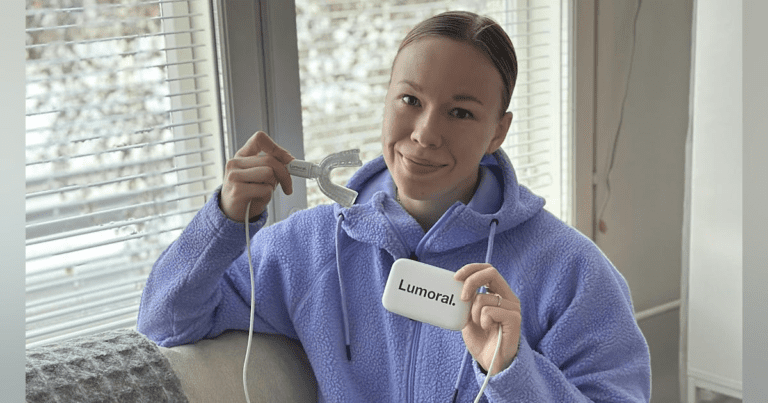A tool to eliminate problem-causing bacteria
The pure bracket study, led by Dr. Roos Jansåker, focuses on teenagers aged 15 to 18 undergoing orthodontic treatment – a group particularly susceptible to plaque build-up and gum inflammation due to the difficulties associated with fixed braces. The trial aims to determine whether light-activated antibacterial therapy, when used in addition to brushing and flossing, can improve plaque control and help manage plaque over time. The Lumoral antibacterial device may also have a photobiomodification (PBM) effect, potentially benefiting periodontal tissue health.
PBM is a non-invasive treatment that has shown positive results in neurosensory rehabilitation, treatment of musculoskeletal injuries and degenerative diseases, and promotes healing in regenerative medicine and dentistry. In dentistry, PBM enhances cellular activity, aiding bone regeneration and stimulating soft tissue. It improves wound healing, reduces postoperative pain and enhances the results of periodontal treatment, improving patient comfort and efficiency. Despite its potential, its use in dentistry has been limited.2.3
Research in PBM has grown rapidly in recent years, with increasing focus on low-level laser therapy and new technologies such as diode lasers in dentistry. The field has evolved – from early topics such as helping to heal dentin and surrounding tissues and improving outcomes in dental treatments (such as cavity fillings) or root canal therapy, to more complex treatments such as tissue regeneration and cell therapy with use of dental pulp stem cells. New research areas, including the detection of caries at an early stage, are emerging rapidly. These lasers can identify changes in tooth structure by measuring how light interacts with enamel and dentin, helping to detect tooth decay early.
PBM is a therapeutic procedure that uses light—usually a low-level laser or LED—to stimulate cell function, promote healing, reduce inflammation, and relieve pain. PBM delivers specific wavelengths of light to cells, which are absorbed by mitochondria (the energy-producing structures inside cells). This absorption increases cellular energy production (ATP), enhancing tissue repair and regeneration.2.3
Braces and Oral Hygiene: Addressing the Challenges and Risks
Dr. Roos Jansåker emphasizes that while orthodontic treatment is common for children and teenagers, fixed appliances such as braces can make it difficult to maintain good oral hygiene. This difficulty often leads to plaque build-up around the braces, increasing the risk of early tooth decay (cavities) and gingivitis.
A Japanese study examining 71 patients of unspecified age found that fixed braces alter the oral microbiome by increasing harmful bacteria associated with gum disease. This bacterial imbalance suggests that braces may predispose people to more serious gum problems, such as periodontitis.4
“Orthodontic treatments, such as braces, are necessary to correct dental alignment in teenagers, but they also have some risks that need to be addressed. We hope to demonstrate that regular antibacterial treatment can significantly benefit adolescents wearing fixed orthodontic appliances,” said Dr. Roos Jansåker.
According to the associate professor, one of the major risks associated with braces is the development of tooth decay. “This is of particular concern for teenagers who often consume a lot of sugary drinks like Coca-Cola and eat candy, and their oral hygiene practices may not be as strict as they need to be, increasing the chance of developing tooth decay.”
While more serious periodontal problems, such as periodontitis (which involves the breakdown of bone around the teeth), are uncommon in teenagers, Dr Roos Jansåker stressed that gingivitis is a common problem. “Gingivitis is a superficial inflammation of the gums caused by plaque build-up and is common among teenagers with braces. Teens should not have gingivitis before getting braces because it can get worse during treatment. This is why maintaining healthy gums is important before beginning orthodontic treatment.”
Another major problem associated with braces is the development of white spots on the teeth. These white areas on tooth enamel, which appear when braces are removed, result from plaque build-up that leads to enamel demineralization due to acid exposure.5
“This is a serious concern because these spots can be permanent and affect the appearance of the teeth,” explained Dr. Roos Jansåker.
Antibacterial treatment for enhanced oral health
Lumoral is a CE-marked medical device recommended by the Finnish Association of Dental Hygienists. It is designed to improve oral health by targeting and reducing harmful bacterial plaque through light-activated antibacterial technology. The device uses antibacterial blue and red light and light-sensitive Lumorinse mouthwash to eliminate harmful plaque bacteria and reduce plaque build-up. It is especially beneficial for people with braces, gingivitis, or people prone to plaque-related oral problems such as tooth decay and gingivitis.
The development of this new method of enhancing oral health was driven by the recognition of the limitations of traditional oral hygiene practices in the effective control of plaque and the prevention of diseases such as periodontitis and caries. The treatment complements brushing and flossing rather than replacing these basic mechanical methods of oral hygiene.6,7
“If a device like Lumoral can demonstrate its effectiveness in reducing plaque around splints, it could be a great tool to minimize these risks. The results from the follow-up tests, especially at the three-month mark, are crucial to evaluate the effect of the device on plaque control. Consistent monitoring and good oral hygiene practices are essential to prevent these common problems associated with orthodontic treatment,” pointed out Dr. Roos Jansåker.
“We are excited to see the final results of this trial as it represents a step forward in improving oral care practices for adolescents. Preliminary findings have shown promising results regarding plaque reduction and inflammation control, and we hope that this study will validate Lumoral as a valuable tool for orthodontic patients,” said Mikko Kylmänen of Koite Health.
Results of the clean arm trial are expected in early spring 2025.


